10 Stunning Succulent Wall Frame Garden Ideas for Your Home
1. Vintage Window Frame Display
Transform an old window frame into a charming succulent display by replacing the glass with wire mesh or chicken wire. Attach small pots or plant directly into soil-filled sections behind the mesh. The contrast between the weathered frame and vibrant succulents creates a rustic focal point perfect for entryways or living rooms.
2. Geometric Wooden Grid
Create a modern statement piece with a geometric wooden grid frame. Build interconnected triangles, hexagons, or diamonds and fill each section with different succulent varieties. This architectural approach showcases succulents’ structural beauty while adding contemporary flair to minimal interiors.
3. Picture Frame Terrariums
Convert multiple picture frames into shallow terrariums by adding backing and a thin layer of cactus soil. Arrange small succulents like Echeverias and Haworthias in artistic patterns. Hang several frames of different sizes together for a gallery wall effect that doubles as a living garden.
4. Monogram Living Initial
Design a personalized statement piece by forming chicken wire into your initial or monogram, mounting it to a wooden backing, and planting succulents throughout. This customized living artwork makes a thoughtful housewarming gift or unique bedroom accent.
5. Shadowbox Vertical Garden
Use a deep shadowbox frame to create a miniature industry with varying heights and textures. Layer rocks, soil, and sand before arranging succulents from tallest to shortest. The depth allows for dramatic plantings with trailing varieties spilling over the edges.
6. Repurposed Drawer Planter
Mount an old wooden drawer horizontally and transform it into a charming wall planter. Line with industry fabric, fill with well-draining soil, and arrange succulents in a flowing pattern. The drawer’s hardware adds vintage character while providing a perfect containment system.
7. Hanging Embroidery Hoop Gardens
Create delicate floating gardens using wooden embroidery hoops. Stretch wire mesh across the hoops, add a backing of moss, then attach small succulents using floral wire. Hang multiple hoops at different heights for a whimsical, floating garden effect in blank wall spaces.
8. Living Picture Frame
Design a true living picture by planting succulents directly into a soil-filled shadow box with a front grid. Select varieties with complementary colors and textures to form a living mosaic that gradually fills in over time, creating ever-changing living art.
9. Industrial Metal Grid
Mount a metal grid or expanded steel sheet to create an industrial-style backdrop for succulents. Attach small pots with wire or specialized clips, allowing for easy rearrangement. This adaptable system works beautifully in urban lofts or modern kitchens.
10. Vertical Pallet Garden
Upcycle a wooden pallet into a substantial wall garden by attaching industry fabric to the back and sides, creating planting pockets between slats. Fill with soil and arrange succulents to cascade between openings. This larger installation makes a dramatic statement on outdoor walls or fence sections.
Creating a Living Art Piece: The Basics of Succulent Wall Frames
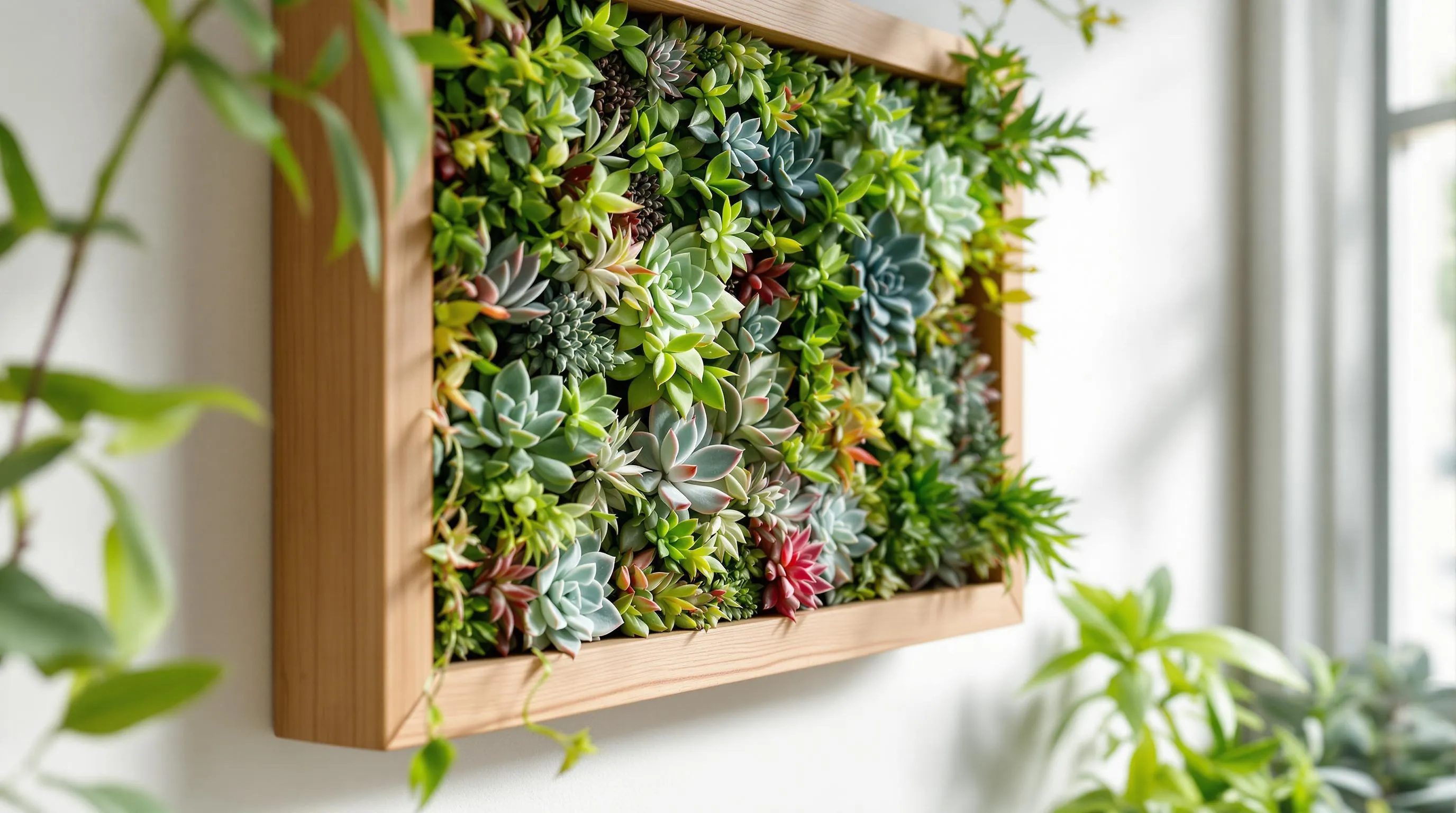
Before diving into your succulent wall frame project, you’ll need to understand the fundamental elements that make these living displays successful. Mastering these basics will ensure your creation thrives as a stunning botanical artwork.
Choosing the Right Frame Structure
Selecting the perfect frame is crucial for your succulent wall garden’s success. Wood frames offer a classic, warm aesthetic but require proper sealing to prevent moisture damage. Metal frames provide industrial durability and sleek lines, working well in contemporary spaces. For beginners, shadowbox frames with depths of 2-3 inches create the ideal planting environment. Consider your frame’s size carefully—larger frames make bold statements but weigh more, requiring secure wall mounting with heavy-duty hardware. The frame’s back should include a solid panel that can be covered with chicken wire or mesh to hold soil while allowing proper drainage. Remember that your frame’s style sets the tone for your entire display, so choose one that complements your existing décor.
Understanding Succulent Varieties for Vertical Gardens
Not all succulents perform equally in vertical settings. Look for compact, slow-growing varieties that won’t quickly outgrow your frame. Echeverias create stunning rosette formations with their symmetrical leaf patterns and come in blues, pinks, and purples. Sempervivums (hens and chicks) offer exceptional hardiness and produce charming offsets that fill spaces naturally. Sedum varieties, particularly low-growing types like ‘Dragon’s Blood’ or ‘Blue Spruce’, cascade beautifully and add textural interest. Haworthias remain small with distinctive patterned leaves and tolerate lower light conditions—perfect for indoor displays. Crassula varieties like ‘Jade Plant’ or ‘String of Buttons’ provide structural interest with their unique growth habits. When selecting plants, consider not just their current size but their mature dimensions, growth rate, and color variations to create a balanced, visually appealing composition that will thrive in your vertical garden environment.
DIY Wooden Picture Frame Succulent Gardens
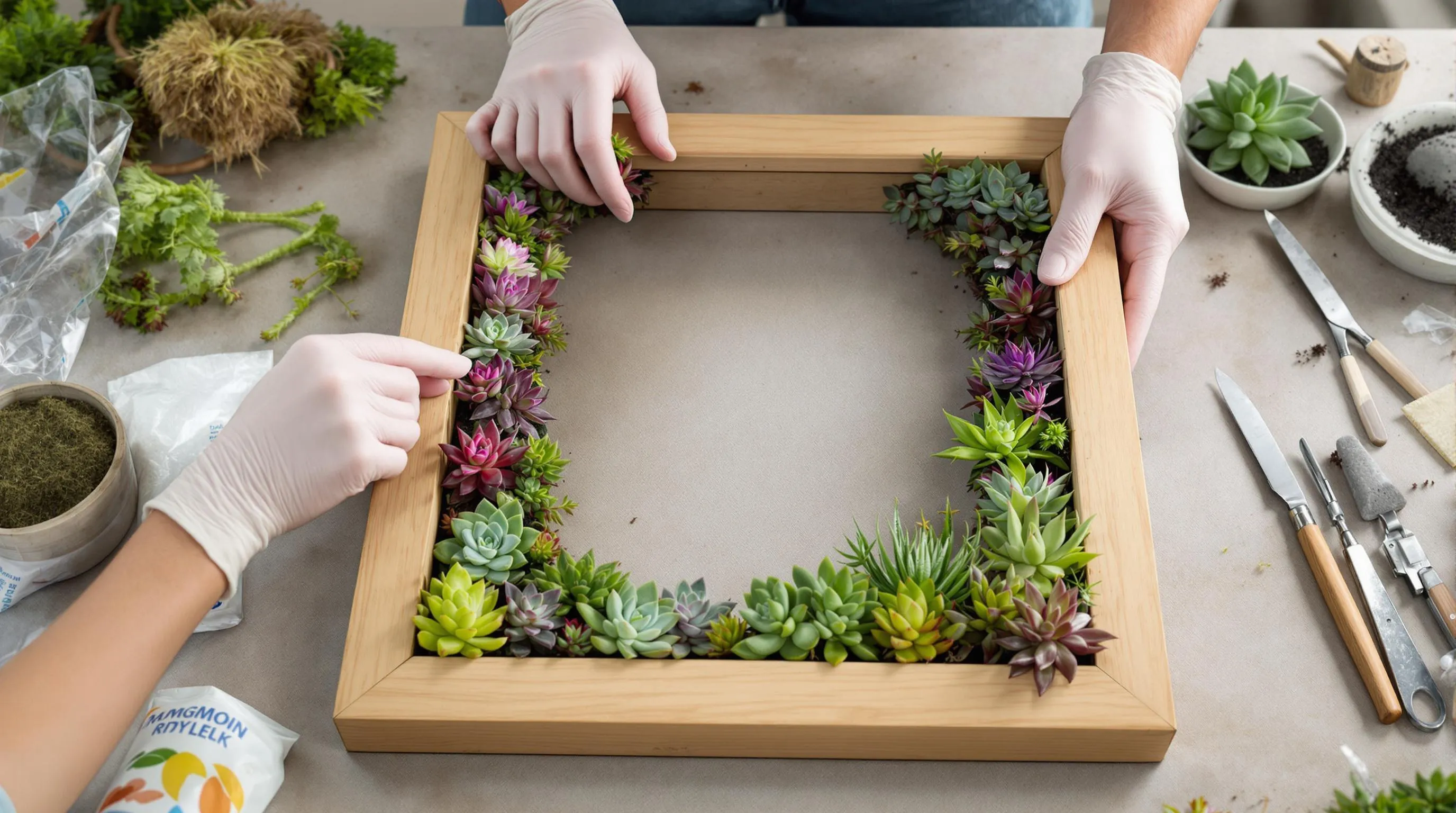
Transform ordinary wooden picture frames into extraordinary living art with these DIY succulent gardens. These projects combine the natural beauty of succulents with the structure of picture frames to create stunning vertical displays for your walls.
Materials and Tools You’ll Need
- Wooden picture frame (deeper shadowbox frames work best)
- Wire mesh or chicken wire
- Industry fabric or coco fiber liner
- Succulent potting mix
- Variety of small succulents
- Sphagnum moss
- Staple gun and staples
- Wire cutters
- Scissors
- Small paintbrush
- Spray bottle
- Picture hanging hardware
- Optional: Wood stain or paint
Step-by-Step Assembly Guide
- Prepare your frame: Remove the glass and backing from your wooden picture frame. If desired, sand and stain or paint the frame to match your décor.
- Create the backing: Cut wire mesh to fit the back of the frame, leaving about 1-2 inches extra on all sides. Secure it to the back of the frame using a staple gun.
- Add the moisture barrier: Cut industry fabric or coco liner slightly larger than the frame opening and place it over the wire mesh. Staple it around the edges, creating a pocket for soil.
- Fill with soil: Hold the frame horizontally and fill the pocket with succulent potting mix, pressing gently to create a firm planting surface while maintaining a depth of at least 1 inch.
- Plant your design: Work with the frame flat on a table. Create a design plan first, then make small holes in the soil and insert succulent cuttings or small plants. Start with larger specimens and fill in with smaller varieties.
- Secure plants: Add sphagnum moss around the plants, tucking it between them to help hold everything in place. Lightly mist the completed arrangement.
- Allow roots to establish: Keep the frame horizontal for 2-4 weeks, watering sparingly to allow the succulents to root into the soil.
- Hang your creation: Once roots are established, attach picture hanging hardware to the back and carefully mount your living artwork on a wall that receives appropriate light for succulents.
Metal Grid Frame Designs for Industrial-Chic Spaces
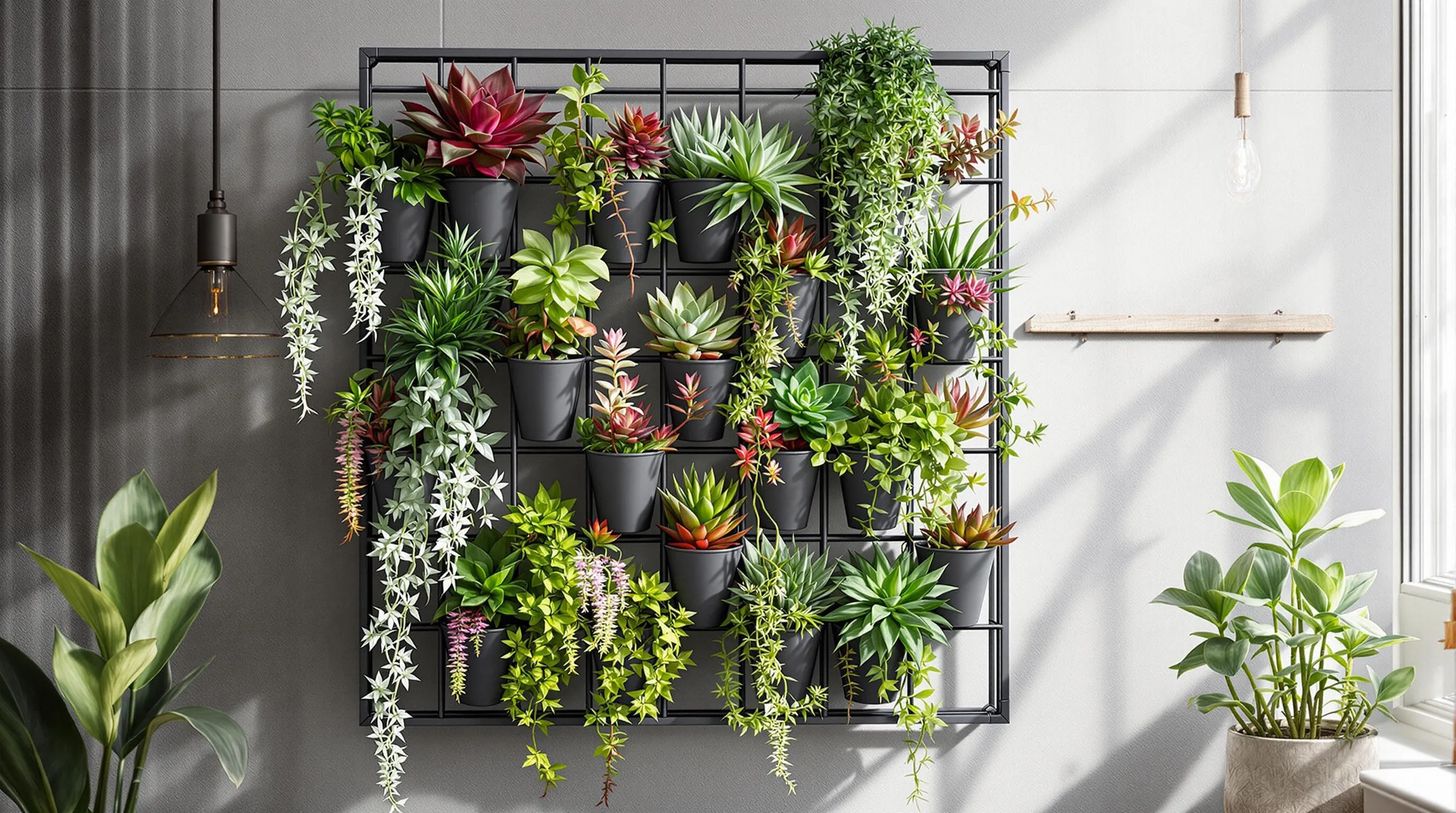
Metal grid frames offer a sleek, contemporary foundation for creating standout succulent displays that complement industrial-chic decor. These minimalist structures allow the natural beauty of succulents to take center stage while adding an urban edge to your living space.
Combining Succulents with Wire Mesh
Wire mesh creates the perfect backdrop for succulents in a modern vertical garden. Start with a sturdy metal grid panel (16-gauge or heavier) and attach small wire pockets or air plant holders at regular intervals. You’ll want to secure these containers firmly with thin gauge wire or zip ties. For a cohesive look, choose succulents in complementary colors—try mixing blue-green Echeverias with burgundy Sempervivums and trailing Senecio rowleyanus (string of pearls). Position larger rosette forms as focal points and fill remaining spaces with smaller varieties. The contrast between the industrial metal and organic plant forms creates a visually striking piece that works perfectly in loft apartments, contemporary offices, or industrial-inspired dining areas.
Weatherproofing Tips for Outdoor Metal Frames
Protecting your metal grid succulent display from the elements ensures its longevity and visual appeal. Choose galvanized or powder-coated steel grids that resist rust naturally. For added protection, apply a clear marine-grade sealant to all metal components before assembly. Line any planting pockets with coco fiber or industry fabric to prevent soil erosion during rainstorms. In regions with high rainfall, drill small drainage holes at the bottom of each planting pocket to prevent water accumulation. During winter months in colder climates, either bring your display indoors or cover it with breathable horticultural fleece when temperatures drop below 40°F. Select cold-hardy succulent varieties like Sempervivum and certain Sedum species for year-round outdoor installations.
Vintage Window Frame Succulent Displays
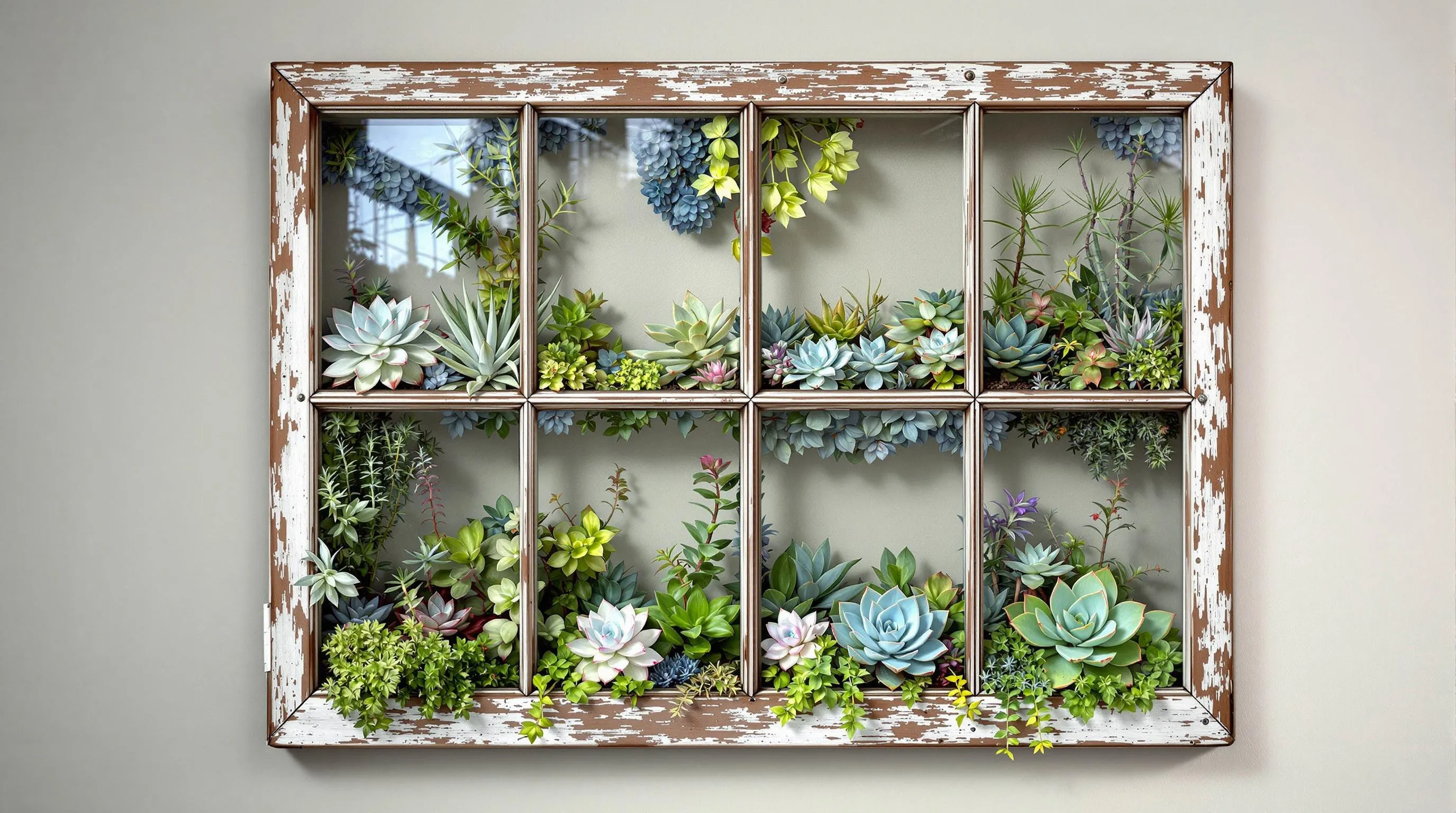
Repurposing Antique Windows as Living Art
Transform forgotten window frames into stunning vertical succulent gardens that blend history with modern plant design. Antique window frames offer ready-made compartments that perfectly showcase different succulent varieties. Start by securing wire mesh or chicken wire to the back of your vintage window using a staple gun or strong adhesive. Layer cactus soil mixed with perlite behind the mesh, creating a thin growing medium that allows you to plant directly into the grid spaces. Choose contrasting succulent varieties like blue Echeverias, trailing String of Pearls, and spiky Haworthias to create visual interest within each window pane. The weathered patina of old wooden frames provides a beautiful contrast to the fresh, vibrant succulents, making each display a unique conversation piece that honors architectural history.
Creating Depth with Multiple Glass Panes
Multi-paned window frames offer exceptional design opportunities by creating natural divisions for your succulent arrangement. You can create dramatic visual depth by removing some glass panes while keeping others intact. The remaining glass panes protect certain succulents while creating reflective surfaces that amplify light. For a dimensional effect, mount smaller succulent varieties like Sedum ‘Little Missy’ in the open sections while placing miniature potted specimens behind the glass panes. This layered approach creates a diorama-like effect that draws viewers in to examine the intricate details. For additional interest, incorporate small decorative elements like polished stones, tiny figurines, or preserved moss between the succulents. Hang your completed window frame garden in a spot that receives filtered light to showcase the interplay between glass, shadows, and living plants.
Shadow Box Succulent Gardens for Depth and Dimension
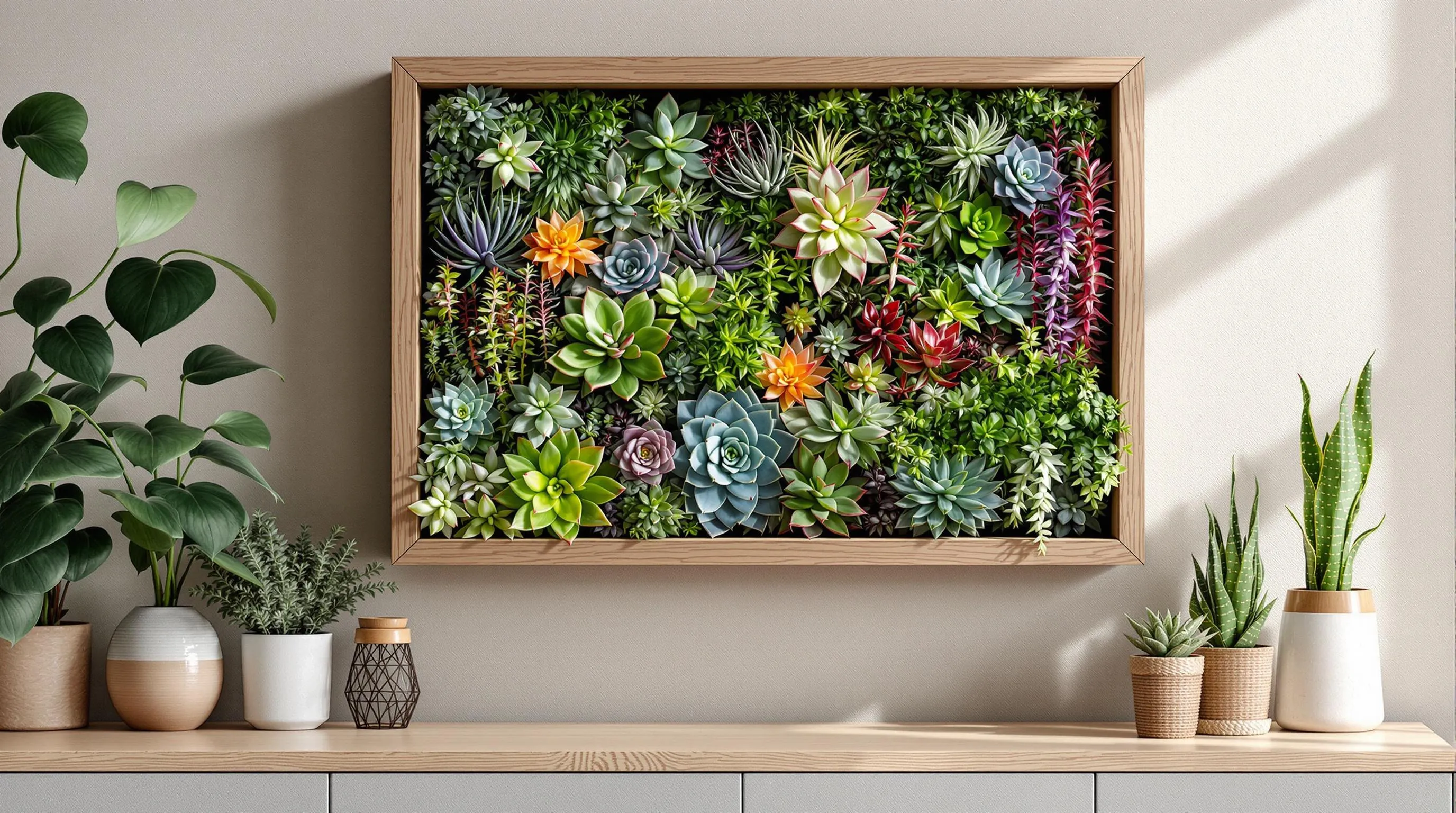
Shadow box frames offer a perfect solution for creating multi-dimensional succulent displays that literally pop from your walls. These deeper frames provide additional space for soil and larger plants, allowing you to create living artwork with remarkable visual depth.
Building a Deep-Set Frame for Larger Plants
To build a shadow box frame for your succulents, start with a wooden box frame at least 2-3 inches deep. Line the interior with plastic sheeting or pond liner to prevent moisture damage. Secure galvanized wire mesh or chicken wire across the front using a staple gun, creating a sturdy base to hold plants in place. Fill the frame with cactus soil mixed with perlite for excellent drainage. For larger specimens, create pockets of deeper soil within the frame where root systems need more space. Aeoniums, larger Echeverias, and small Haworthias work beautifully in these deeper settings, creating dramatic focal points among smaller varieties. Remember to let the frame rest horizontally for 2-3 weeks before hanging to allow roots to establish firmly.
Creating Visual Interest with Varying Heights
Maximize the visual impact of your shadow box by strategically arranging succulents of different heights and growth habits. Place taller varieties like Kalanchoe tomentosa (Panda Plant) or Crassula perforata (String of Buttons) toward the back of the frame, creating a natural backdrop. Position medium-height plants like Echeveria elegans in the middle ground, and trail Senecio radicans (String of Bananas) or Sedum morganianum (Burro’s Tail) near the edges to cascade downward. This layering technique creates a three-dimensional effect that catches light and casts subtle shadows, adding remarkable depth to your living wall art. For additional drama, incorporate small air plants (Tillandsia) that can be nestled between succulents without needing soil contact, further improving the textural complexity of your display.
Geometric Pattern Succulent Arrangements
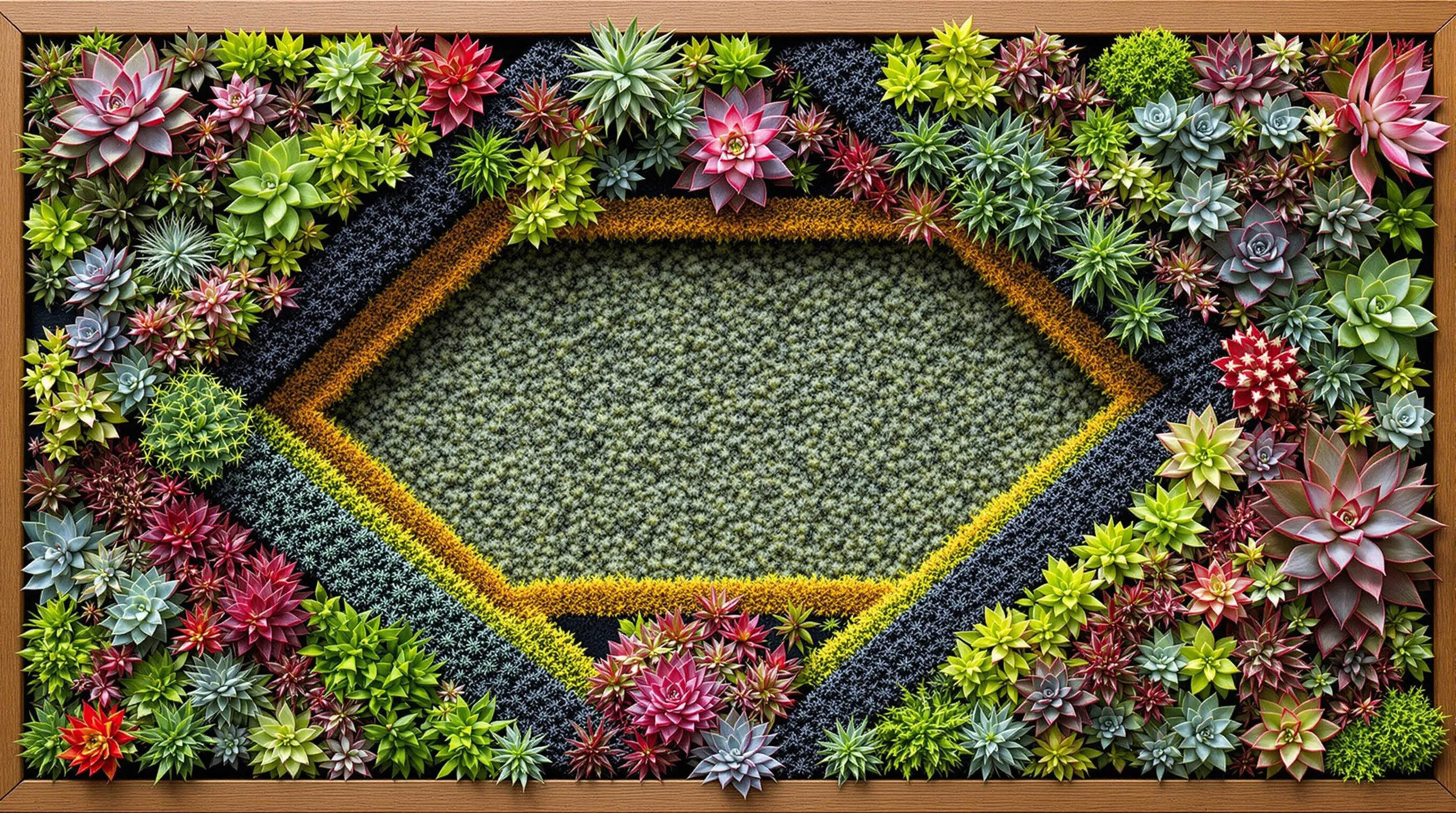
Transform your wall frame garden into a living geometric masterpiece by arranging succulents in striking mathematical patterns. Geometric designs bring order and visual rhythm to your living art, creating a contemporary statement piece that draws attention. You’ll find that succulents are perfect for creating these structured designs thanks to their compact growth habits and architectural forms.
Designing with Color and Texture Contrast
Create stunning visual impact by pairing succulents with contrasting colors and textures in your geometric arrangement. Position blue-gray Echeverias next to bright green Sedums or place spiky Haworthias alongside smooth Pachyphytums for dramatic effect. Use the natural color wheel to your advantage—arrange complementary colors like purple Sempervivums against golden Crassulas to make both pop. For sophisticated monochromatic designs, select succulents in varying shades of the same color family, creating subtle gradients that add depth. Try organizing your arrangement in repeating triangles, concentric circles, or honeycomb patterns to emphasize the contrasting elements while maintaining geometric precision.
Maintaining Shape as Plants Grow
Keep your geometric patterns looking pristine by selecting slow-growing succulent varieties and implementing regular maintenance. Choose compact rosette formers like Echeveria ‘Lola’ or Sempervivum ‘Ruby Heart’ that maintain their shape over time. Trim any leggy growth immediately to preserve your design’s clean lines and prevent plants from obscuring neighboring specimens. Install your succulents with adequate spacing (1-2 inches apart) to accommodate growth while maintaining the pattern structure. Schedule quarterly pruning sessions to remove offsets, which helps control expansion and keeps your geometric design intact. For symmetrical patterns, rotate your frame regularly to ensure even sun exposure, preventing plants from leaning and distorting your carefully crafted arrangement.
Indoor Living Room Succulent Wall Features
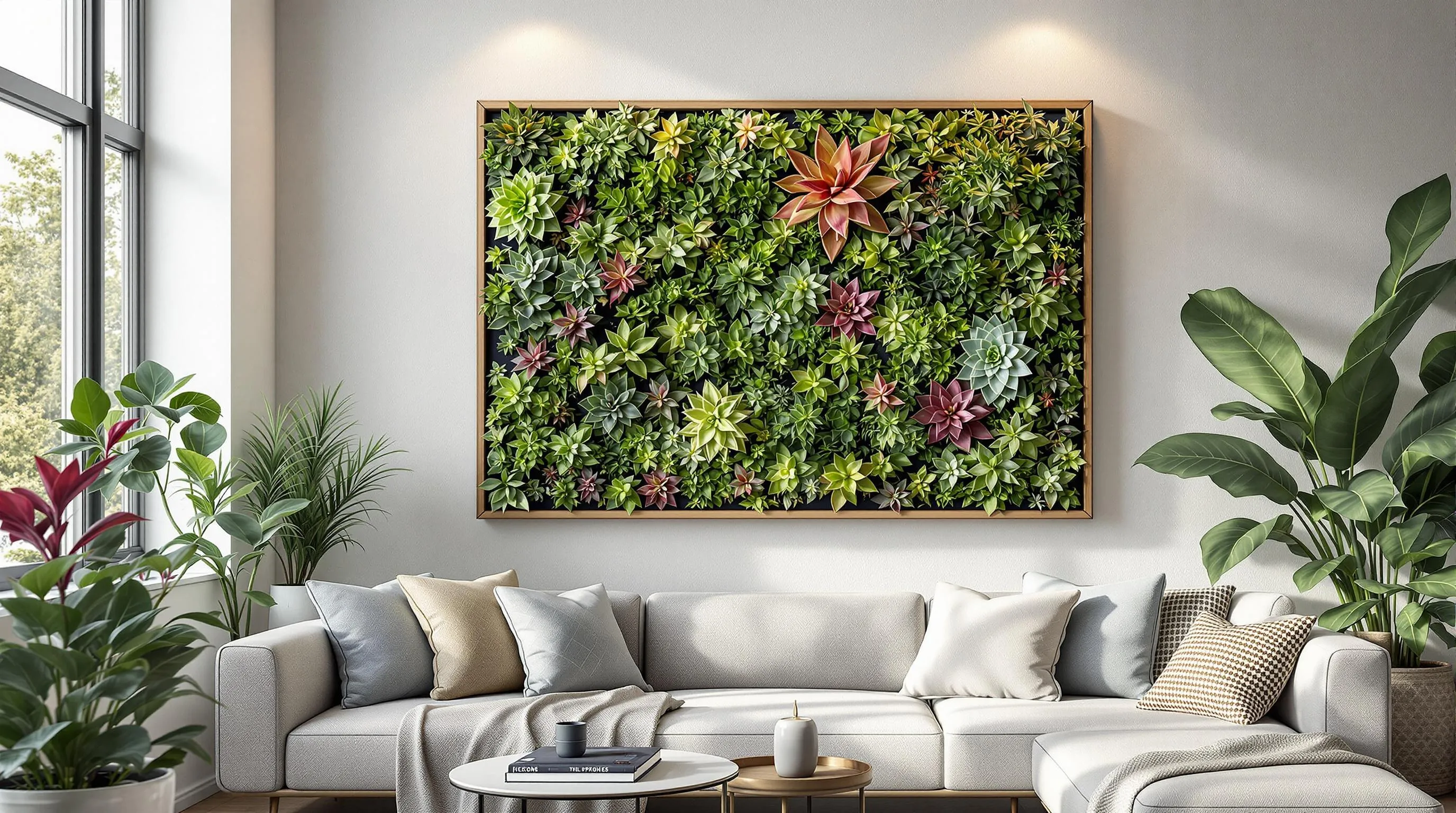
Transforming your living room with a succulent wall feature creates a stunning focal point that brings nature indoors while maximizing your space. These living installations add texture, color, and organic elements that complement various interior design styles.
Lighting Considerations for Indoor Success
Proper lighting is essential for indoor succulent walls to thrive in your living room. Position your succulent frame in a spot that receives 4-6 hours of bright, indirect sunlight daily – typically near south or east-facing windows. For rooms with limited natural light, supplement with full-spectrum LED grow lights positioned 12-18 inches away from your plants. Rotate your succulent frame quarterly to ensure even growth, as succulents will naturally lean toward light sources. Be mindful of excessive heat from windows that might scorch your plants in summer months, and avoid placing your living wall directly above heating vents that can dry out the soil too quickly. Plants like Haworthia, Gasteria, and some Aloe varieties perform better in lower light conditions, making them ideal choices for dimmer living rooms.
Incorporating into Existing Decor
Integrate your succulent wall feature by selecting frames that complement your living room’s existing color palette and style. For minimalist spaces, choose simple wooden or white frames that let the plants be the focal point. In bohemian-inspired rooms, opt for ornate vintage frames or macramé-adorned displays that enhance the eclectic vibe. Create cohesion by echoing your room’s accent colors in your succulent selection – burgundy Echeverias pair beautifully with similar tones in throw pillows or artwork. Position your living wall at eye level where it can be fully appreciated, such as above a sofa or in conversation areas. For maximum impact, install subtle frame lighting with small LED strips to highlight the dimensional qualities of your succulent arrangement during evening hours. Consider creating a gallery wall effect by hanging smaller succulent frames alongside artwork and photographs for a curated, designer look that elevates your living space.
Outdoor Succulent Wall Gardens for Patios and Porches
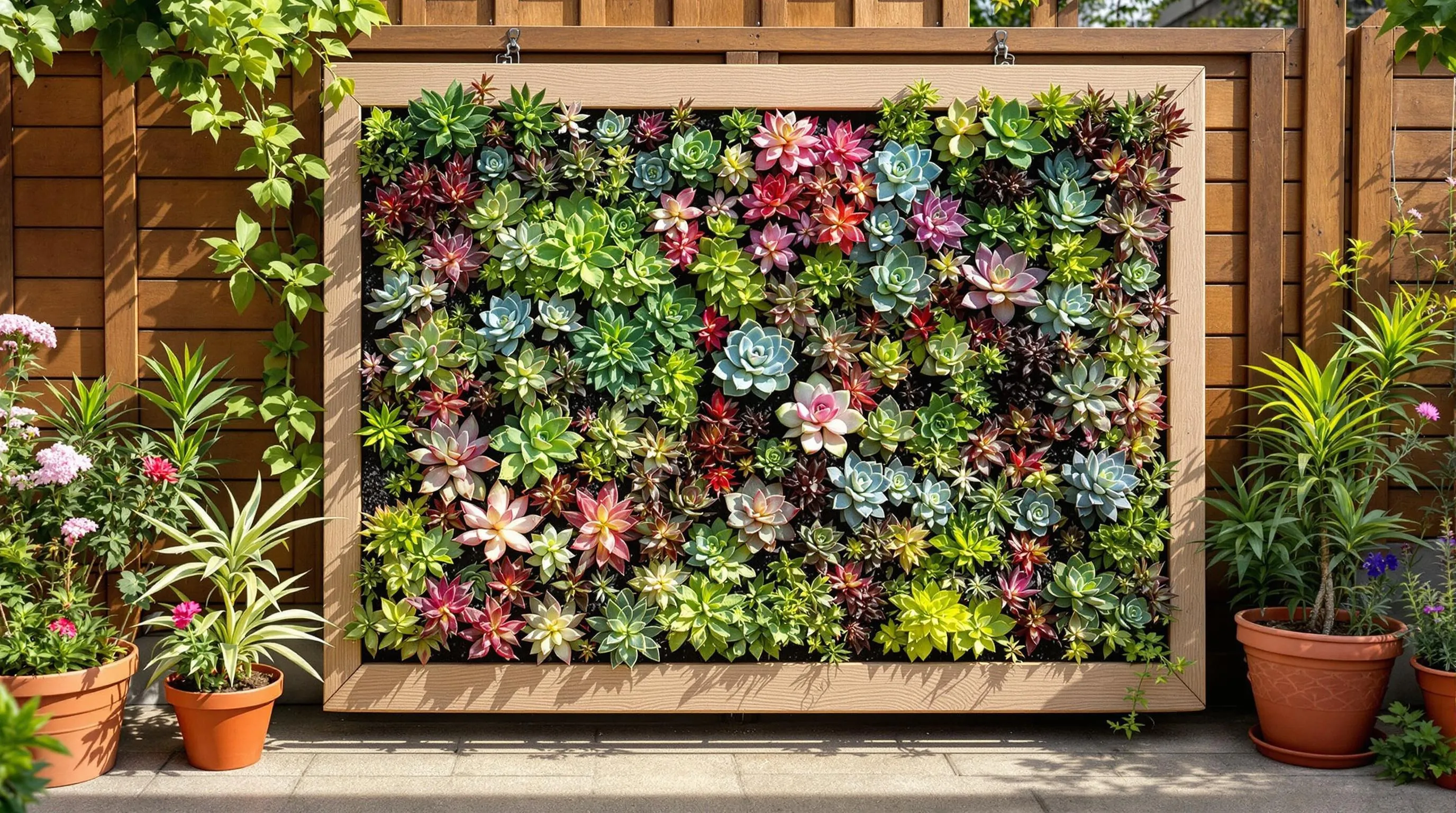
Transform your outdoor living spaces with vibrant succulent wall gardens that thrive in the open air. These vertical displays add dimension and natural beauty to patios and porches while maximizing limited space.
Weather-Resistant Frame Options
For outdoor succulent displays, weather-resistant frames are essential to ensure longevity. Cedar and redwood frames offer natural resistance to moisture and insects, making them ideal for humid environments. Opt for pressure-treated lumber sealed with marine-grade varnish for maximum durability in rainy climates. Metal frames constructed from powder-coated steel or aluminum provide excellent weather resistance while creating a contemporary aesthetic. For coastal areas, consider composite materials that withstand salt spray and intense sun exposure. Repurposed items like old gates or window shutters treated with weather-resistant sealants offer rustic charm while providing necessary protection. Always select frames with proper drainage systems—integrated channels or strategically placed holes prevent water accumulation that could damage both the frame and plants during heavy rainfall.
Seasonal Care for Outdoor Displays
Outdoor succulent wall gardens require seasonal maintenance to thrive year-round. During summer, monitor water needs closely—morning watering prevents leaf burn while allowing foliage to dry before evening. Install temporary shade cloth over your displays during extreme heat waves to prevent scorching. In fall, reduce watering frequency as growth slows and plants prepare for dormancy. Before winter arrives, move portable frames to sheltered locations or install clear protective covers for permanent installations in regions where temperatures drop below freezing. Apply preventative fungicide treatments during humid periods to combat potential rot issues. Spring calls for fertilizing with low-nitrogen succulent food to encourage healthy growth after winter dormancy. Perform seasonal pruning to maintain your design’s aesthetic and remove any frost-damaged sections. Rotate your frames quarterly to ensure even sun exposure, especially for displays mounted on walls receiving partial sunlight.
Miniature Succulent Frame Gardens for Small Spaces
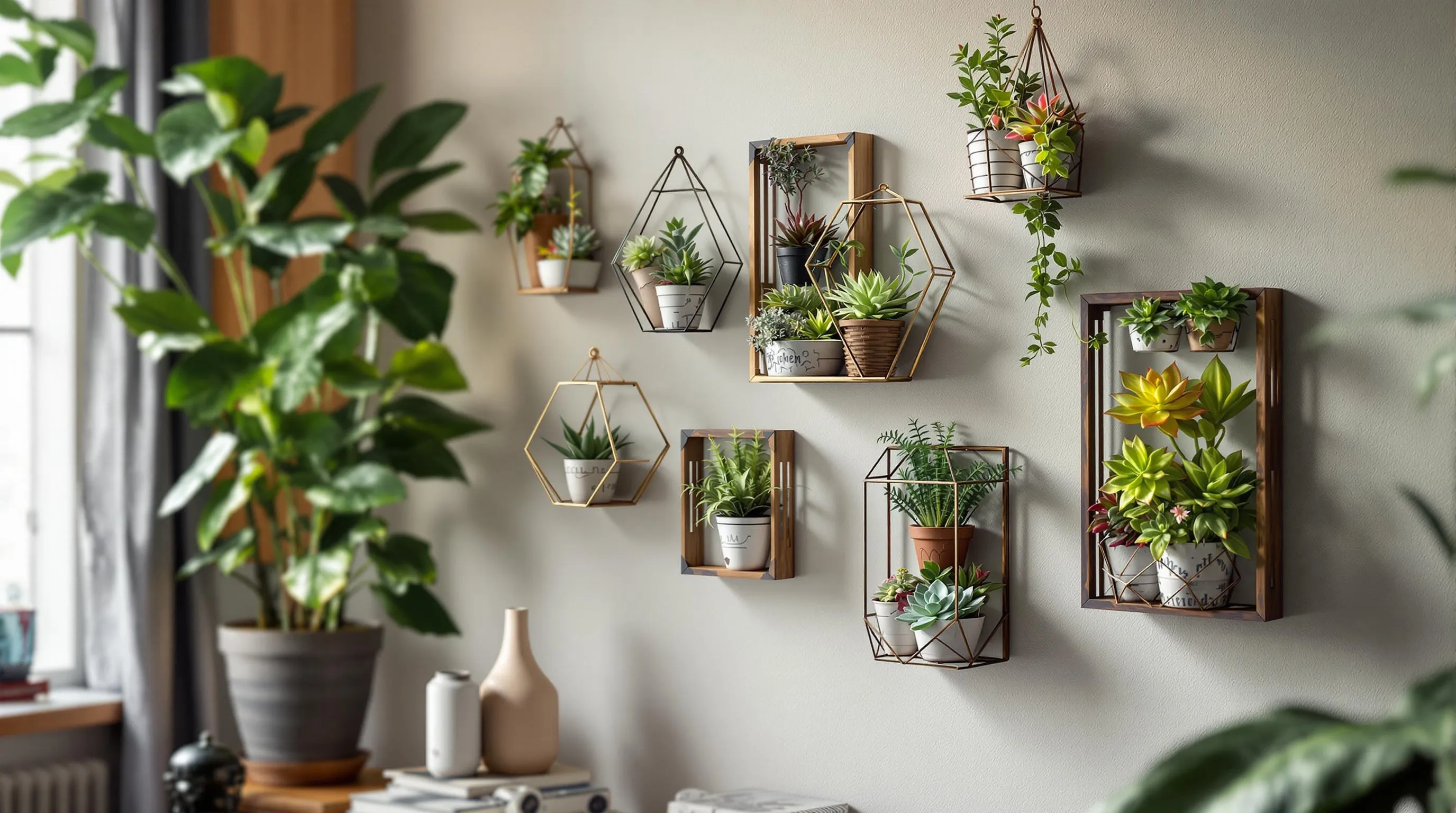
Even with limited space, you can enjoy the beauty of succulent frame gardens by scaling down to miniature versions. These compact displays pack all the visual impact of their larger counterparts while fitting perfectly in apartments, small homes, or any area where space is at a premium.
Desk and Tabletop Options
Transform your workspace or dining area with miniature succulent frames that measure just 5-8 inches across. These petite living artworks create instant focal points without consuming valuable surface area. Choose shallow shadow box frames with 1-2 inch depths to accommodate tiny succulent varieties like Echeveria ‘Perle von Nürnberg’, Crassula ‘Baby Necklace’, or Sedum ‘Little Missy’. For a modern look, opt for geometric metal frames with glass fronts that showcase your mini arrangement while protecting delicate plants. You can also repurpose vintage photo frames by attaching small air plants with floral wire for a no-soil option that requires minimal maintenance—perfect for office desks or nightstands.
Space-Saving Vertical Designs
Maximize your small space by thinking vertically with wall-mounted miniature succulent frames. Create a striking gallery wall using multiple 4×6 or 5×7 inch frames arranged in clusters, allowing you to enjoy an extensive succulent collection without sacrificing floor space. Magnetic frames work brilliantly on metal surfaces like refrigerators or filing cabinets—simply attach small containers holding individual succulents to create a customizable living display. For rental-friendly options, try hanging lightweight frames from curtain rods or picture rails using decorative chains or macramé hangers. These vertical designs draw the eye upward, creating the illusion of more space while introducing natural elements to even the smallest rooms.
Maintaining Your Succulent Wall Frame Garden
Your succulent wall frame garden transforms ordinary space into a living masterpiece that brings nature’s beauty indoors. Whether you’ve created a geometric pattern design a repurposed window frame or a miniature tabletop display your living wall art adds character and tranquility to any room.
Remember that these vertical gardens require minimal care but do benefit from occasional attention. Check soil moisture every few weeks trim any leggy growth and rotate outdoor frames seasonally to maintain their stunning appearance.
With proper placement and thoughtful design your succulent wall garden will continue to evolve becoming more beautiful with time. This perfect blend of gardening and art lets you express your creativity while enjoying the calming presence of these resilient plants in even the smallest spaces.





